
Mummy portraits or Fayum mummy portraits are a type of naturalistic painted portrait on wooden boards attached to upper class mummies from Roman Egypt. They belong to the tradition of panel painting, one of the most highly regarded forms of art in the Classical world. The Fayum portraits are the only large body of art from that tradition to have survived. They were formerly, and incorrectly, called Coptic portraits.

The Nefertiti Bust is a painted stucco-coated limestone bust of Nefertiti, the Great Royal Wife of Egyptian pharaoh Akhenaten. It is on display in the Egyptian Museum of Berlin.

The Legion of Honor, formally known as the California Palace of the Legion of Honor, is an art museum in San Francisco, California. Located in Lincoln Park, the Legion of Honor is a component of the Fine Arts Museums of San Francisco, which also administers the de Young Museum.

Sobekneferu or Neferusobek was a pharaoh of ancient Egypt and the last ruler of the Twelfth Dynasty of the Middle Kingdom. She ascended to the throne following the death of Amenemhat IV, possibly her brother or husband, though their relationship is unproven. Instead, she asserted legitimacy through her father Amenemhat III. Her reign lasted 3 years, 10 months, and 24 days, according to the Turin King List.

The art of Ancient Rome, and the territories of its Republic and later Empire, includes architecture, painting, sculpture and mosaic work. Luxury objects in metal-work, gem engraving, ivory carvings, and glass are sometimes considered to be minor forms of Roman art, although they were not considered as such at the time. Sculpture was perhaps considered as the highest form of art by Romans, but figure painting was also highly regarded. A very large body of sculpture has survived from about the 1st century BC onward, though very little from before, but very little painting remains, and probably nothing that a contemporary would have considered to be of the highest quality.

Jebel Barkal or Gebel Barkal is a mesa or large rock outcrop located 400 km north of Khartoum, next to Karima in Northern State in Sudan, on the Nile River, in the region that is sometimes called Nubia. The jebel is 104 m tall, has a flat top, and came to have religious significance for both ancient Kush and ancient Egyptian occupiers. In 2003, the mountain, together with the extensive archaeological site at its base, were named as the center of a World Heritage Site by UNESCO. The Jebel Barkal area houses the Jebel Barkal Museum.

Ancient Egyptian art refers to art produced in ancient Egypt between the 6th millennium BC and the 4th century AD, spanning from Prehistoric Egypt until the Christianization of Roman Egypt. It includes paintings, sculptures, drawings on papyrus, faience, jewelry, ivories, architecture, and other art media. It was a conservative tradition whose style changed very little over time. Much of the surviving examples comes from tombs and monuments, giving insight into the ancient Egyptian afterlife beliefs.
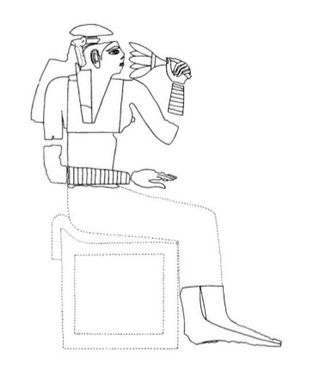
Hetepheres I was a queen of Egypt during the Fourth Dynasty of Egypt who was a wife of one king, the mother of the next king, the grandmother of two more kings, and the figure who tied together two dynasties.

Reserve heads are distinctive sculptures made primarily of fine limestone that have been found in a number of non-royal tombs of the Fourth Dynasty of Egypt; primarily from the reigns of pyramid-building pharaohs Khufu to Khafre, circa 2551–2496 B.C. While each of the heads share characteristics in common with each other, the striking individuality of the pieces makes them some of the earliest examples of portrait sculpture in existence. Their purpose is not entirely clear; the name comes from the prevalent theory first put forward in 1903 by the German Egyptologist Ludwig Borchardt, that the head was to serve as an alternate home for the spirit of the dead owner should anything happen to its body.
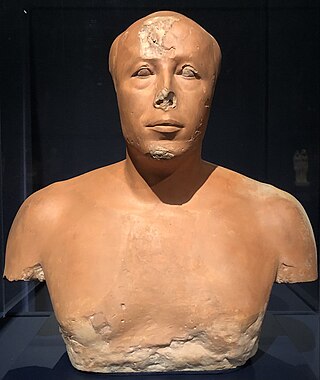
Ankhhaf was an Egyptian prince and served as an overseer during the reign of the Pharaoh Khufu, who is thought to have been Ankhhaf's half-brother. One of Ankhaf's titles is also as a vizier, but it is unknown under which pharaoh he would have held this title. He lived during Egypt's 4th Dynasty.

The Art & History Museum is a public museum of antiquities and ethnographic and decorative arts located at the Parc du Cinquantenaire/Jubelpark in Brussels, Belgium. The museum is one of the constituent parts of the Royal Museums of Art and History (RMAH) and is one of the largest art museums in Europe. It was formerly called the Cinquantenaire Museum until 2018. It is served by the metro stations Schuman and Merode on lines 1 and 5.
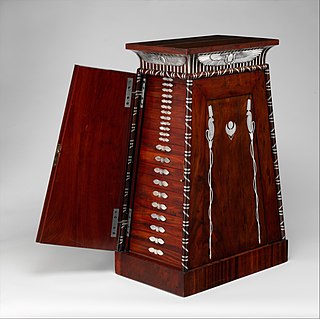
Egyptian revival decorative arts is a style in Western art, mainly of the early nineteenth century, in which Egyptian motifs were applied to a wide variety of decorative arts objects.

Portraiture in ancient Egypt forms a conceptual attempt to portray "the subject from its own perspective rather than the viewpoint of the artist ... to communicate essential information about the object itself". Ancient Egyptian art was a religious tool used "to maintain perfect order in the universe" and to substitute for the real thing or person through its representation.

The East Field is located to the east of the Great Pyramid of Giza and contains cemetery G 7000. This cemetery was a burial place for some of the family members of Khufu. The cemetery also includes mastabas from tenants and priests of the pyramids dated to the 5th and 6th Dynasty.
Frederick Warren Allen (1888–1961) was an American sculptor of the Boston School. One of the most prominent sculptors in Boston during the early 20th century and a master teacher at the School of the Museum of Fine Arts, Allen had a career in the arts that spanned more than 50 years.
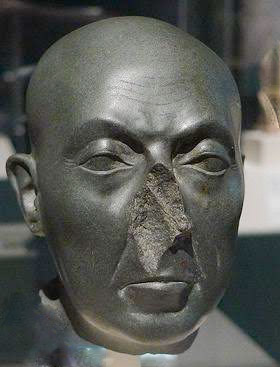
The Boston Green Head is a greywacke sculptured head of an Egyptian priest from the Late Period of ancient Egypt. The head is dated to 380–332 BC and is housed in the Museum of Fine Arts, Boston, United States.

The Statue of Sobekneferu was a sculpture of the ancient Egyptian queen Sobekneferu, who reigned during the 12th Dynasty.

Palmyrene funerary reliefs are almost 4000 busts on decorative slabs closing burial niches inside underground tombs, produced in Palmyra over three centuries from the middle of the first century BC. It is the largest corpus of portrait sculpture in the Roman world outside Rome and the largest collection of funerary representations from one place in the classical world.
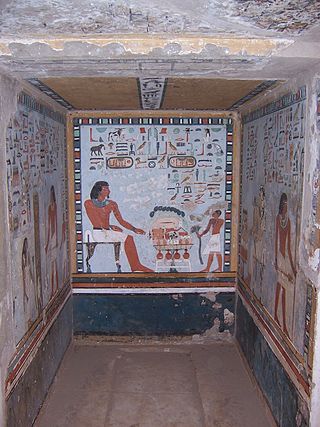
Sarenput II, also called Nubkaurenakht was an ancient Egyptian nomarch during the reign of pharaohs Senusret II and Senusret III of the 12th Dynasty.

The Passage of the Delaware is a large, Neoclassical 1819 oil-on-canvas painting by Thomas Sully. With attention to historical accuracy, the painting depicts George Washington on horseback observing the troops of the American Revolutionary Army in the process of crossing the Delaware River prior to the surprise attack on Hessian troops on the night of December 25 and 26, 1776, at the Battle of Trenton. The image is intended to capture the moment prior to George Washington dismounting his horse and joining his army in crossing the Delaware River.
Cf. J. Assmann, Preservation and Presentation of Self in Ancient Egyptian Portraiture, in Studies in Honor of William Kelly Simpson Volume 1, pp. 55–81. Edited by Peter Der Manuelian. Boston: Department of Ancient Egyptian, Nubian, and Near Eastern Art, Museum of Fine Arts, Boston 1996.




















